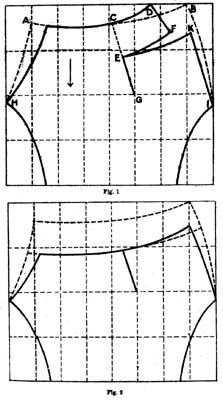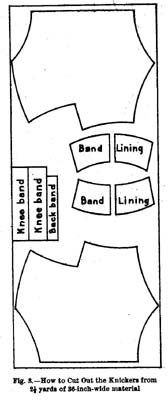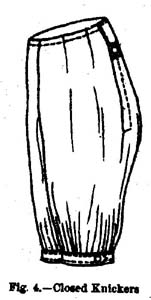From the woman's drawers pattern shown previously a pattern of closed knickers may be developed These have usually the back part cut lower than the front, and set into a separate band, fastening upon the remainder of the garment several inches below the waist. The only other important difference is the narrowing of the pattern for neatness, especially if thick material is being used.
Sometimes the waistband is cut in one with the garment, as shown in the diagram below, sometimes the section CDEF forms a band cut by itself and sewn to the front.
 The opening in a woman's knickers should not be cut straight down, nor in the middle of the garment, but is much more satisfactory when cut as shown in Fig. 1, although rather more difficult to finish.
The opening in a woman's knickers should not be cut straight down, nor in the middle of the garment, but is much more satisfactory when cut as shown in Fig. 1, although rather more difficult to finish.
The dotted lines show the lines of the drawers pattern on which alterations are made.
At AH and BI the curves for front and back lines are changed so as to narrow the garment towards the waist.
CD is the line CD shortened so as to form the waist line of the back band.
EF is cut parallel to CD, and DF at right angles to CD and EF.
EK may be cut parallel to CB, or may be slightly raised towards the back so as to allow plenty of room.
The band CDEF may be cut away so as to form a separate band, or may be left as part of the garment. If it forms a separate band CE should be placed selvedge-way in cutting out.
 The only point in the alterations requiring explanation would be the position of the line CD. In the original pattern the point B gives the necessary height above I, and it would not be possible to reduce this height without tightening the garment too much. (As a matter of fact, when knickers are closed, more rather than less height is required to allow sufficient room.) CD is simply the line CB shortened because no gathering is required.
The only point in the alterations requiring explanation would be the position of the line CD. In the original pattern the point B gives the necessary height above I, and it would not be possible to reduce this height without tightening the garment too much. (As a matter of fact, when knickers are closed, more rather than less height is required to allow sufficient room.) CD is simply the line CB shortened because no gathering is required.
N.B.—Although this modification is shown on the woman's type of knickers, similar alterations could be made on the girl's and even the child's type if desired.
Fig. 2 shows the alterations required on the pattern if it is preferred to have a complete circular band. The pattern is cut at the line marked for the circular band (the back being raised a little), narrowed to avoid bulk, and the opening cut down. The usual back band would be required, which would be fastened upon the back of the circular band. The circular band would be cut in the usual way.
Making Up Closed. Knickers
Materials.—Almost any material may be used—cotton, gingham, zephyr, wincey, serge, tweed. This is a garment most suitably sewn by machine.
Side Openings.—Since the side openings are cut on a slope, and therefore a little difficult to handle and liable to fray out, it is a good plan to finish them before beginning to join the seams. The only satisfactory method of finishing is that described on p. 189. They must be carefully handled so as not to pucker them.
Seams must be worked exactly as described for children's knickers with side opening.
Kneebands.—For closed knickers the kneebands are usually closed with a button and button-hole. A slit about 3 or 4 inches long should be cut in the outside of each leg exactly opposite the seam, and finished like the side openings, care being taken that the front of the leg overlaps the back, whereas the side opening the back must overlap the front. The material may be gathered, stroked, and set into the band; but if stroking is impossible, it should be gathered twice, the wrong side of the band stitched to the gathers, and the right side then folded down, the band being stitched all round to make it firm and neat.
 Waist.—The front portion must be narrowed with darts to bring it to the right width. A narrow cross-way false hem must then be put on to finish the raw edges. The waistbands, if not forming part of the garment, must be attached to the fronts by stitching. If
cut in one with the garment they must be lined, and the
lining should match the material with regard to the selvedge-way.
Waist.—The front portion must be narrowed with darts to bring it to the right width. A narrow cross-way false hem must then be put on to finish the raw edges. The waistbands, if not forming part of the garment, must be attached to the fronts by stitching. If
cut in one with the garment they must be lined, and the
lining should match the material with regard to the selvedge-way.
If a circular band is used the front must be gathered, pleated, or narrowed with darts before being set into it, the whole band being stitched round to finish it.
Back.—The back may be narrowed by gathers, pleats, or darts, and set into the back band, which should be equal in width to the two back waistbands when they are closed.
Fastenings.—Two buttons and two button-holes will be required on the waistbands unless draw-strings are inserted at the waist. The draw-strings should be placed in position before the waistbands are stitched together, being firmly stitched to the lining of the bands, and the left-hand one should be brought to the right side through an eyelet- or button-hole worked on one thickness of the material, so as to allow the band to overlap a little.
Three button-holes must be made on the back band to fasten on buttons placed at the bottom of the waistbands. The bottom button on the waistband may be used for the middle button-hole of the back band. A button and button-hole will be required on each kneeband.
N.B.—Women's knickers of thin material may be finished without openings, but with elastic at knees and waist, just like the children's knickers shown in Fig. 6.